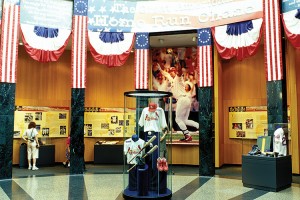Baseball Eyes on Cooperstown
Wednesday, August 2nd, 2017August 2, 2017
On Sunday, July 30, Major League Baseball (MLB) greats Jeff Bagwell, Tim Raines, and Iván Rodríguez were inducted into the National Baseball Hall of Fame in Cooperstown, New York. Bagwell, a slugging first baseman, was elected in his seventh year of eligibility. Voters named him on 86 percent of the ballots, easing him above the 75 percent required for election. Raines, one of the game’s greatest lead-off men, also earned 86 percent of the vote. It was the 10th and final year of eligibility for Raines (see final paragraph for Hall of Fame eligibility rules). Rodríguez, earning his way on the first try (a rare honor), was the game’s premier catcher during his long tenure in the big leagues. Long-time executive John Schuerholz and former commissioner and team owner Bud Selig were also enshrined in the Hall of Fame on Sunday.

The National Baseball Hall of Fame and Museum in Cooperstown, New York, honors players and other individuals who made outstanding contributions to the sport. Credit: © Andre Jenny, Alamy Images
Bagwell, an awesome power hitter with a trademark wide stance at the plate, played 15 seasons for the Houston Astros. He was the 1991 National League (NL) Rookie of the Year (an annual award for the best first-year player), and in the strike-shortened 1994 season, Bagwell hit .368 with 39 homers and 116 runs batted in (RBI’s) in just 110 games to earn the NL Most Valuable Player (MVP) award. He also earned a Gold Glove award that season as the NL’s best defensive first baseman. From 1996 through 2001, Bagwell put up staggering offensive numbers, averaging at least 30 home runs, 100 runs scored, and 100 RBI’s. The slugger’s career came to a quick end with shoulder injuries after 2005, a season in which he helped the Astros to their first and only World Series appearance.
Raines, an outfielder whose consistency and physique earned him the nickname “Rock,” first tasted the majors in 1979 with the Montreal Expos. In his first full season in 1981 (the only other MLB season shortened by a player strike), Raines hit .304, paced the NL with 71 stolen bases, and made the first of seven consecutive All-Star teams. He continued to hit, steal bases, and score runs until his retirement after the 2002 season at age 42. After his run with the Expos, Raines spent significant time with the Chicago White Sox and New York Yankees.

Hall of Fame catcher Iván Rodríguez played four full seasons for the Detroit Tigers. Credit: © Pete Hoffman, Shutterstock
Rodríguez, a native of Puerto Rico, came to the big leagues as a 19-year-old prospect for the Texas Rangers in 1991. In an abbreviated rookie season, he showed off dazzling defensive skills, a potent bat, and a cannon of an arm. The following year, his first full season, he earned the first of 14 All-Star appearances and 13 Gold Gloves. Rodríguez dominated the game at the plate, from behind it, and even on the bases. In his greatest season in 1999, Rodríguez hit .332 with 35 home runs, 113 RBI’s, 116 runs scored, and 25 stolen bases. He edged out (now fellow) Hall of Famers Roberto Alomar and Pedro Martinez as that year’s American League MVP. Known affectionately as “Pudge” (a somewhat chubby reference borrowed from Hall of Fame catcher Carlton Fisk), Rodríguez played 21 seasons with the Rangers, Florida Marlins, Detroit Tigers, Yankees, and Washington Nationals.
John Schuerholz served as general manager of the Kansas City Royals from 1981 though 1990. He then ran a talented Atlanta Braves team through the 2007 season. Both the Royals and Braves won a World Series under his leadership. Allan “Bud” Selig brought MLB back to Milwaukee with the Brewers in 1970 (the Braves had played there from 1953 through 1965). Selig owned the Brewers into the early 1990′s, when MLB turbulence pushed him into the role of commissioner. Selig oversaw some dramatic changes as MLB’s chief executive, a position he held until 2015.
Hall of Fame voting is based upon a player’s record, playing ability, integrity, sportsmanship, character, and contributions to the team(s) on which the player played. Votes are cast by members of the Baseball Writers’ Association of America, which consists of writers with 10 consecutive years of service in the association. To be eligible, ballplayers must have spent at least 10 seasons in the majors and been retired for 5 years (exceptions are made in the case of severe injury or sudden death, such as with Roberto Clemente). Eligible players remain on the Hall of Fame ballot for 10 years, after which they can gain entry only though the select Eras Committee (formerly the Veterans Committee)—a rare occurrence. The Eras Committee, made up of former executives, managers, players, and umpires, also chooses nonplayers such as Schuerholz and Selig for entry into the Hall of Fame.


